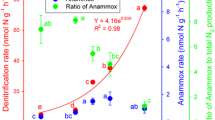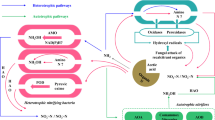Abstract
The nature of nitrification in the organic horizons (FH) of two heathland soils was studied. Two types of chemolithotrophic nitrification but no heterotrophic nitrification were detected in the acid heathland humus. One type was predominant in slow nitrate producing humus. It was acid-sensitive but could be stimulated by urea at low pH. The other type was acid-tolerant, it was not stimulated by urea. The latter type was predominant in fast nitrate producing humus. The occurrence of acid-tolerant chemolithotrophic nitrification provides indirect evidence for the existence of previously unknown acid-tolerant, chemolithotrophic, ammonium-oxidizing bacteria. Nitrification by these micro-organisms may be an important source of soil acidification in acid soils that are exposed to high levels of ammonium deposition.
Similar content being viewed by others
References
De Boer W, Duyts H and Laanbroek H J 1988 Autotrophic nitrification in a fertilized acid heath soil. Soil Biol. Biochem. 20, 845–851.
De Boer W, Duyts H and Laanbroek H J 1989 Urea stimulated autotrophic nitrification in suspensions of fertilized, acid heath soil. Soil Biol. Biochem. 21, 349–354.
De Boer W and Laanbroek H J Ureolytic nitrification at low pH byNitrosospira spec. Arch. Microbiol.In press.
Focht D D and Verstraete W 1977 Biochemical ecology of nitrification and denitrification. Adv. Microb. Ecol. 1, 135–214.
Hankinson T R and Schmidt E L 1984 Examination of an acid forest soil for ammonia- and nitrite-oxidizing autotrophic bacteria. Can. J. Microbiol. 30, 1125–1132.
Hankinson T R and Schmidt E L 1988 An acidophilic and a neutrophilicNitrobacter strain isolated from the numerically predominant nitrite-oxidizing population of an acid forest soil. Appl. Environ. Microbiol. 54, 1536–1540.
Houba V J G, Van der Lee J J, Walinga I and Novozamsky I 1985 Soil Analysis Procedures. Agricultural University, Wageningen, The Netherlands.
Hyman M R and Wood P M 1985 Suicidal inactivation and labelling of ammonia mono-oxygenase by acetylene. Biochem. J. 227, 719–725.
Keeney D R and Nelson D W 1982 Nitrogen-inorganic forms.In Methods of Soil Analysis. Eds. A L Page, R H Miller and D R Keeney, pp 643–698. Agronomy 9, Part 2, 2nd edn., Madison, Wisconsin, USA
Killham K 1987 A new perfusion system for the measurement and characterization of potential rates of soil nitrification. Plant and Soil 97, 267–272.
Kreitinger J P, Klein T M, Novick N J and Alexander M 1985 Nitrification and nitrifying microorganisms in an acid forest soil. Soil Sci. Soc. Am. J. 49, 1407–1410.
Martikainen P J and Nurmiaho-Lassila E-L 1985Nitrosospira, an important ammonium-oxidizing bacterium in fertilized coniferous soil. Can. J. Microbiol. 31, 190–197.
Morrill L G and Dawson J E 1962 Growth rates of nitrifying chemoautotrophs in soil. J. Bacteriol. 83, 205–206.
Mulder J 1988 Impact of acid atmospheric deposition on soils: Field monitoring and aluminum chemistry. Doctoral thesis. Agricultural University, Wageningen, The Netherlands.
Parnow R J 1972 Computer program estimates bacterial densities by means of most probable numbers. Food Technol. 26, 56–62.
Robertson L A 1988 Aerobic Denitrification and Heterotrophic Nitrification inThiosphaera panthotropha and Other Bacteria. Doctoral Thesis. University of Technology, Delft, The Netherlands.
Schimel J P, Firestone M K and Killham K 1984 Identification of heterotrophic nitrification in a Sierran forest soil. Appl. Environ. Microbiol. 48, 802–806.
Topp E and Knowles R 1872 Nitrapyrin inhibits the obligate methylotrophsMethylosinus trichosporium andMethylococcus capsalatus FEMS Microbiol. Lett. 14, 47–49.
Van Breemen N, Burrough P A, Velthorst E J, Van Dobben H F, De Wit T, Ridder T B and Reijnders H F R 1982 Soil acidification from atmospheric ammonium sulphate in forest canopy throughfall. Nature 299, 548–550.
Van Breemen N, Mulder J and Grinsven J J M 1987 Impacts of acid atmospheric deposition on woodland soils in the Netherlands: II. Nitrogen transformations. Soil Sci. Soc. Am. J. 51, 1634–1640.
Wall L L, Gehrke C W, Neuner T E, Cathey R D and Rexnord P R 1975 Cereal protein nitrogen: Evaluation and comparison of four different methods. J. Assoc. Off. Anal. Chem. 58, 811–817.
Weber D F and Gainey P L 1962 Relative sensitivity of nitrifying organisms to hydrogen ions in soils and solutions. Soil Sci. 94, 138–145.
Author information
Authors and Affiliations
Rights and permissions
About this article
Cite this article
De Boer, W., Gunnewiek, P.J.A.K., Troelstra, S.R. et al. Two types of chemolithotrophic nitrification in acid heathland humus. Plant Soil 119, 229–235 (1989). https://doi.org/10.1007/BF02370413
Received:
Revised:
Issue Date:
DOI: https://doi.org/10.1007/BF02370413




